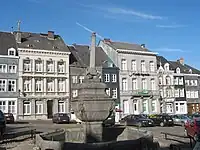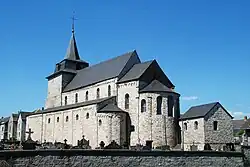Remaclus
Saint Remaclus (Remaculus, Remacle, Rimagilus; died 673) was a Benedictine missionary bishop.
Remaclus | |
|---|---|
 Statue of Saint Remaclus, Saint Sebastian's church in Stavelot. | |
| Bishop | |
| Born | late 6th or early 7th century Duchy of Aquitaine |
| Died | between 671 and 676 Stavelot, Imperial Abbey of Stavelot-Malmedy (now Belgium) |
| Venerated in | Eastern Orthodox Church Roman Catholic Church |
| Major shrine | Stavelot Abbey |
| Feast | September 3 |
| Attributes | Generally accompanied by a wolf |
| Patronage | the Ardennes |
Life
Remaclus grew up at the Aquitanian ducal court and studied under Sulpitius the Pious, bishop of Bourges. In 625 he became a monk at Luxeuil Abbey and was then ordained a priest. Around 631 Saint Eligius founded Solignac Abbey and sent for monks from Luxeil, including Remaclus, who became the first abbot.[1] The abbey followed the rule as at Luxeil. Audoin wrote that Solignac quickly gained importance. It became particularly known for its silversmith's workshop.[2]

Remaclus was then given charge as well of the abbey of Cougnon, in the duchy of Luxemburg. He served as an advisor to Sigebert III of Austrasia and persuaded him to establish the double-monastery of Malmedy in 648 and Stavelot in 650. Remaclus served as abbot of Stavelot and Malmedy.[1] Erected as an ecclesiastical principality attached to the Holy Roman Empire, its head bore the title of Prince-Abbot.[3]

In 650 Amandus, bishop of Maastricht, resigned his see to resume missionary work.[4] Remaclus was appointed in his stead. He brought with him Hadelin, then abbot of Visé. His student Theodard succeeded him as abbot of the double monastery of Stavelot-Malmedy.[5]
Inhabitants of this troubled diocese had murdered some of his predecessors. However, Remaclus successfully spread monasticism in the region. He served as the spiritual teacher to Saint Trudo, Saint Babolen, Saint Theodard of Maastricht, and Saint Lambert. Remaclus served as bishop for twelve years before resigning in favor of Theodard, and retiring to Stavelot around 662.[6] He died at Stavelot in 664. [7] His relics lie in St. Sebastian Church in Stavelot. His feast day is September 3. It is commonly held that if it rains on this day, it is a good sign, because then as much grain sprouts from the earth as raindrops fall on the field.
Popular legends speak of him being accompanied by a wolf, able to drive away the devil who wanted to destroy the newly built churches. With his staff, the saint is said to have discovered springs that were considered healing waters.
.jpg.webp) Saint Remacle - Malmedy
Saint Remacle - Malmedy.jpg.webp) St Remacle, Liège Cathédrale
St Remacle, Liège Cathédrale.JPG.webp) St. Remaclus, Waldorf
St. Remaclus, Waldorf_06.jpg.webp) St. Hilarius, Maspelt
St. Hilarius, Maspelt
There are a number of churches named after him located mainly in western Germany in the Eifel and Moselle regions, as well as in the Belgian, Luxembourg and French Ardennes. There is a St. Remaclus Parish Church in Cochem, Germany. The abbeys of Stavelot-Malmedy ceased to exist at the time of the French Revolution. In 1950 St. Remaclus' Priory, Wavreumont was established between Stavelot and Malmedy.
References
- Schäfer, Joachim. "Remaclus von Stablo", Ökumenischen Heiligenlexikon
- Havard, Henry. Histoire de l'orfèvrerie française Paris. Librairies-imprimeries réunies, 1896, p. 69
- "Histoire", Ville de Stavelot
- Butler, Alban. "St. Amandus, Bishop and Confessor", The Lives of the Saints, Vol. III, 1866
- Watkins, Basil. "Theodard of Maastricht", The Book of Saints, Bloomsbury Publishing, 2015 ISBN 9780567664150
- Butler. Alban. "Saint Remaclus, Bishop of Maestricht, Confessor". Lives of the Fathers, Martyrs, and Principal Saints 1866. CatholicSaints.Info. 27 August 2014
 This article incorporates text from this source, which is in the public domain.
This article incorporates text from this source, which is in the public domain. - Monks of Ramsgate. "Remaclus". Book of Saints 1921. CatholicSaints.Info. 2 September 2016
 This article incorporates text from this source, which is in the public domain.
This article incorporates text from this source, which is in the public domain.